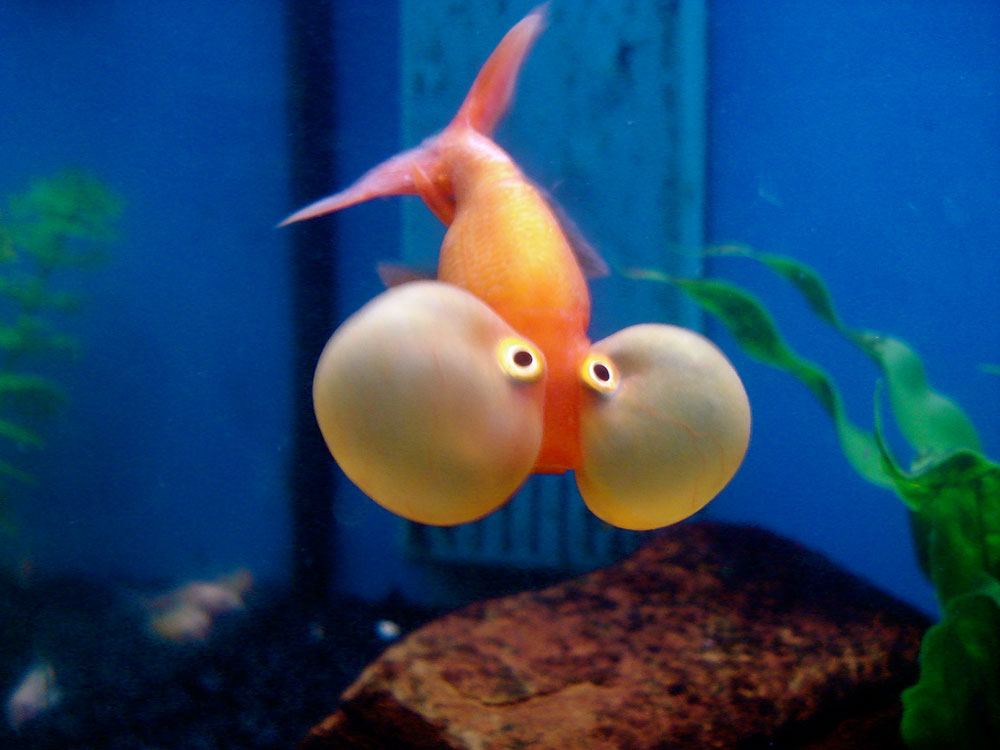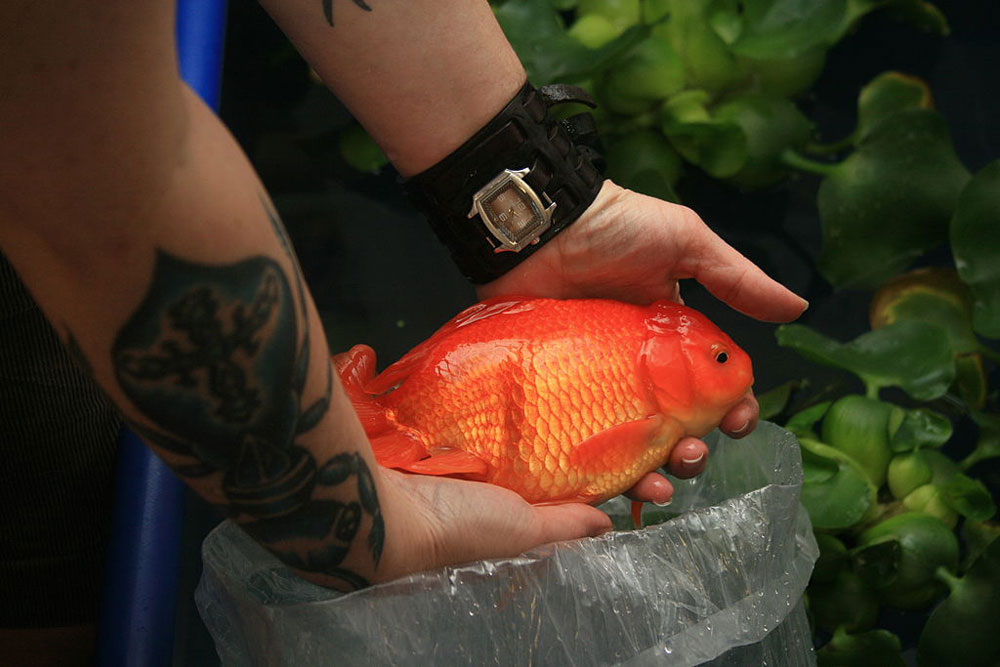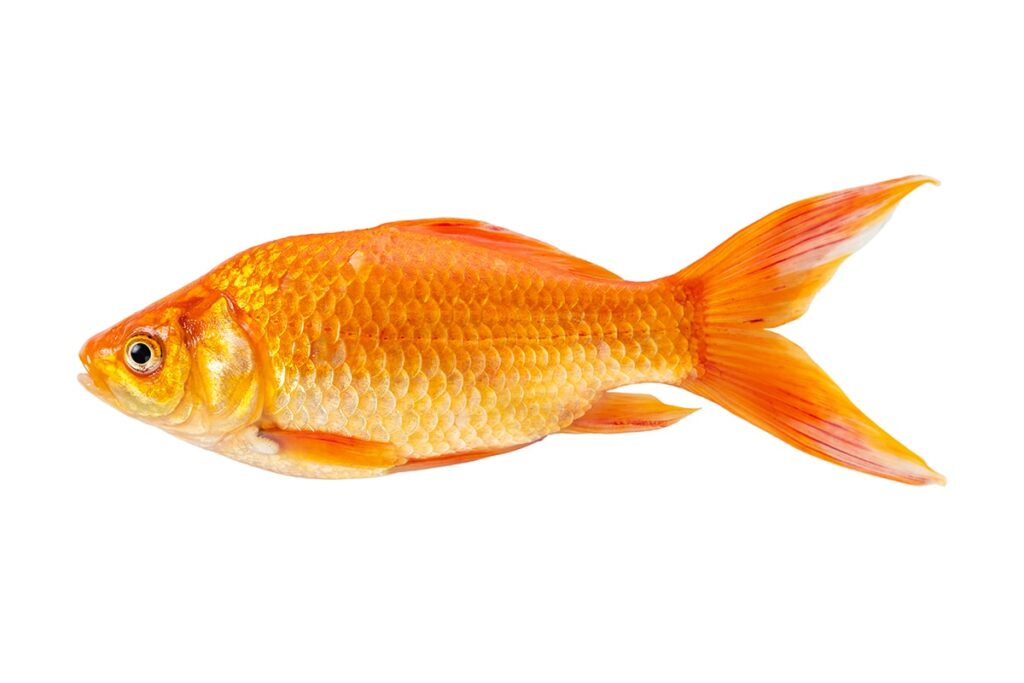- Open eyes: Goldfish can’t close their eyes because they don’t have eyelids
- Color: If you keep a goldfish in a dark room, it will lose its color. Similarly, goldfish that live outdoors will typically be more colorful than goldfish that live indoors (because they get more daylight)
- Memory: Goldfish can remember for at least 3 months; not the infamous 2-3 seconds they are notorious for (you can read more about the memory of goldfish in the last section of this page)
- Intelligence: Goldfish can distinguish between different shapes, colors and sounds, and can be trained to recognize and respond to certain light signals. They can even learn tricks
- Urine: Goldfish (and other fish) don’t urinate like mammals do. Instead, they excrete ammonia into the water via their gills
- Sight: Goldfish can see infrared radiation and ultraviolet light (which humans and most other animals cannot)
- No stomach: Goldfish do not have stomachs and should therefore be fed several small portions rather than one large one
- Oldest goldfish: The world’s oldest goldfish lived to be 45 years old and died in 2005. The fish lived with the Evans family in Bradninch, Devon in the UK and was won at a market in 1960
- Cold water: Goldfish significantly lower their metabolism in cold water, making them virtually hibernate. This means, among other things, that they can survive in very low water temperatures (including lakes that have been frozen over the winter)
- Size: The growth of goldfish is greatly hampered by their small aquarium sizes, improper feeding and poor water quality. Therefore, goldfish can grow much larger than we are used to; the world’s longest goldfish is 47.4 cm long and lives with its owner Joris Gijsbers in the Netherlands

Fact: There are more than 300 breeding species of goldfish, the vast majority of which originate from China. Pictured here is the ‘bubble eye’ (Carassius auratus auratus auratus)
More facts about goldfish
- History as a pet: Goldfish were originally kept as pets in ancient Chinese dynasties. It wasn’t until the early 16th century that they became popular outside of China. In 1603 they reached Japan, in 1611 Europe and around 1850 the USA (it wasn’t until 1853 that aquarium water filtration was discovered, making it possible to keep fish in aquariums indoors). So goldfish have been kept as pets for at least 2000 years!
- Food: Goldfish are omnivorous, eating plants, insects, small arthropods and even smaller fish
- Touch: Never touch a goldfish as this can damage the mucus membrane that naturally protects its scales from infection
- Sounds and noise: Goldfish have hearing and become stressed by loud noises and vibrations in the water. Therefore, tapping your fingers on the aquarium (or generally making noise) to activate the goldfish inside is not recommended
- Survival: Although many goldfish die relatively quickly due to improper care and handling by their owners, goldfish are able to survive in relatively poor living conditions. One example of this was Smokey the goldfish, who was found alive in 2013 in a house that had burned down in 2011 in Essex, UK. The goldfish had survived in a few centimeters of water in a small covered garden pond with no access to fresh water, food or daylight for 2 years

Goldfish can grow larger than most people think. The largest goldfish today is 47.4 cm long and lives in the Netherlands. Pictured is a large Oranda goldfish from England
Who are the enemies of goldfish?
Goldfish have a variety of natural enemies and threats, both in the wild and in home aquariums:
- Predatory Fish: Larger fish, such as koi, catfish, and some species of cichlids, may attack and eat goldfish, especially if they are kept in the same pond or aquarium.
- Birds: Birds like herons, kingfishers, and seagulls often prey on goldfish, particularly in outdoor ponds.
- Mammals: Raccoons, otters, and even some domestic cats can pose a threat to goldfish in outdoor water features.
- Amphibians: Large frogs and toads may try to eat smaller goldfish, especially if the fish live in a pond.
- Parasites and Diseases: Goldfish are susceptible to various parasites (such as ich or anchor worms) and diseases (like fin rot and swim bladder disease) that can harm or kill them.
- Human Factors: Poor water quality, overfeeding, and improper tank maintenance can also be enemies of goldfish in captivity, leading to stress and health issues.
Each of these factors represents a significant threat to the health and well-being of goldfish in different environments.
Facts about the memory of goldfish
A popular belief suggests that goldfish have a memory span of only three seconds. This myth has been widely spread in popular culture, making people think these small aquatic creatures have extremely short attention spans. However, scientific studies have proven that this is not the case.
Goldfish are much more intelligent than they appear, with a memory span that can last for months, not seconds. Research has shown that goldfish can learn and retain information over long periods. In experiments, they have been trained to associate certain sounds or colors with feeding times, proving that they remember these cues long after the initial training period.
In fact, goldfish have demonstrated abilities such as recognizing their owners and remembering routes in complex mazes. These cognitive capabilities are a testament to their surprising intelligence and learning capacity.
So, while the myth of the three-second memory persists, science shows that goldfish are much more capable than commonly believed.


